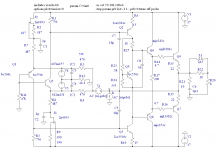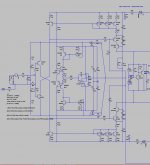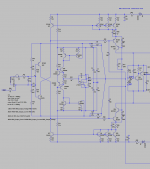Yes please, Guru Zan!Just so there's no confusion, is this the CFA you want to analyse the outer loop?
Du.uuh! Should be ..Bear in mind that improving the stability of the 'inner VAS/OPS' loop using bigger Cherry caps, may decrease stability of the 'outer/main' loop.
Bear in mind that improving the stability of the 'inner VAS/OPS' loop using smaller Cherry caps, may decrease stability of the 'outer/main' loop.
Yes please
This does what I think you want.
smaller Cherry caps, may decrease stability of the 'outer/main' loop.
I knew what you meant😉
Attachments
Last edited:
What an elegant solution!This does what I think you want.
I grovel at your feet in thanks Oh Guru Zan 🙂
Some quick sims with my #4 offering for which I have done stability analysis using many different tools back to about 1980 show that this is indeed exactly what I'm after (for CFAs).
I tried to replicate the dodgy sims that seem to suggest Guru Zan's Tian on the output before the Cherry take-off pts weren't exactly equivalent to my Tian probes on the VAS input (to look at the VAS/OPS Cherry 'inner' loop). It appears I inadvertently removed my 0.1pF placeholders across the feed back resistor leading to the discrepancy.
Mea maxima culpa. 😱
Now that I have the proper tools .. I ken pre10 2 x10 dis stability sh*t 2 CFAs 😀
Agreed. Loadsa other stuff needed to turn this into a real amp including but not justThe input needs RF decoupling or the loop behavior will be off and dependent on the source.
- bandwidth limiting
- Supply rails & decoupling
- Earthing arrangements
Dave Zan. This is in concept very much like my CFA amplifier, except that my Drivers are lateral mosfets, Also my housekeeping is different as i have made a +/- 12 V supply where I mirror in the drive currents, this allows for a simple implementation of an offset servo.
Anyway I find i interesting that the compensation can look so simple. I look forward to get my PCB's and experiment to see how it behaves and if this simple cherry can keep it stable.
Anyway I find i interesting that the compensation can look so simple. I look forward to get my PCB's and experiment to see how it behaves and if this simple cherry can keep it stable.
So in this simulation you see the OLG of the amplifier with the CLG of the output stage or do i misunderstand the function of the tian probe..??
/M
/M
Dave Zan. This is in concept very much like my CFA amplifier...
Just to be clear. The amplifier is entirely of Richard Lee's creation.
My contribution was only to demonstrate the way to
1. See the Return Ratio for the VAS + OPS loop in an Output Inclusive Compensated amplifier.
And then, separate problem, to
2. See the Return Ratio for the outer loop when that feedback loop splits to a pair of inputs.
So in this simulation you see the OLG of the amplifier with the CLG of the output stage or do i misunderstand the function of the tian probe..??
We use the Tian probe to see the Return Ratio (=Loop Gain, more or less) of a loop, the outer loop in the latest post.
Very important to understand that neither OLG or CLG are actually the gain of any loop and we don't use the Tian probe to look at them.
The comments in the LTSPice example seem to be incorrect.
The actual circuit is correct and very cleverly done by Frank Wiedmann but the comments seem to be by someone else who didn't quite understand.
The words "open loop gain" should be "loop gain".
The Middlebrook "GFT" probe does include the CLG in the calculation but the extra complication is not usually needed.
Best wishes
David
Last edited:
And just to be even clearer, my circuit in #262 is only a proposal for which I asked Guru Zan to provide an important missing tool to investigate stability. Without this tool, I was unable to do the full tests described in #1 and also more stuff I've pontificated on later in this and other threads.
Without doing the full series of tests, I would not want to present this as a 'finished' design .. especially as I've no 'real life' experience with anything similar.
Now I have the correct tools, it may still be some time before I get round to doing these SPICE world tests on CFAs as they take quite a lot of time & effort.
_________________
Without doing the full series of tests, I would not want to present this as a 'finished' design .. especially as I've no 'real life' experience with anything similar.
Now I have the correct tools, it may still be some time before I get round to doing these SPICE world tests on CFAs as they take quite a lot of time & effort.
_________________
MiiB, I'll just repeat my recommendation that your PCB allow for decouping the VAS emitter resistors (R6/10 in #262) with 100p - 1n NPO/CGO ceramics.MiiB said:This is in concept very much like my CFA amplifier, except that my Drivers are lateral mosfets,
Will you post your *.ASC or a pic of your circuit?Also my housekeeping is different as i have made a +/- 12 V supply where I mirror in the drive currents, this allows for a simple implementation of an offset servo.
I have already the circuit running with "normal miller compensation, so the cherry (including VAS resistors/caps) is "just" a parallel option on the next set of evaluation PCB's. Unfortunately I can't disclose the circuit here, as it does not belong to me.
... I asked [for] an important ... tool
Well, you asked for two tools in fact.😉
But I have finally realized you only needed to have one.
To solve the dual path Tian probe I first recommended that you check a Paul Hurst paper, before I saw a simpler way.
But that recommendation made me reexamine Paul's paper and reminded me of his results for multi-loop feedback.
He discusses when a multi-loop structure can be analysed as if there is just one loop.
He proves that this can be done if a point exists that cuts all the loops at once.
This is intuitively plausible, that one point "sees" all the feedback and the return ratio there contains information about all the loops.
All the different feedback paths are effectively in parallel with respect to that point so the analysis effectively simplifies to just one loop.
Now for an OIC/Cherry amplifier that point is immediately after the OPS, where I placed the first Tian probe.
I claimed that the second, outer loop probe provided incomplete information.
That is true but not the full story.
In fact the outer loop probe is completely superfluous.
I am pleased to have finally worked this out, but sorry it took a while for the relevance of the article to sink in.
Once I had the answer and knew what to search for I was able to find that this had already been noted, but only by a very few people.
The earliest is someone called MikeK, I expect that won't make it easier to convince you.😉
I also expect the Hurst's proof is solid but I haven't checked it yet.
In particular I want to see what he assumes about reverse transmission in the loop and loop bypass transmission.
I have installed Middlebrook's ominously named "Final Solution" probe, the complete catastrophe with not 2, not 3, not even 4 but 5 assorted current injectors, voltmeters, current monitors etc.
So that's the current area of research.
Best wishes
David
Last edited:
...The earliest is someone called MikeK.
Also known as Michael Kiwanuka.😎
Also known as Michael Kiwanuka.😎
Yes, I realized that, hence the 😉 for Richard and credit where it's due from me.
Best wishes
David
Last edited:
There is the small matter of 'real life'. Unlike MikeK, I like my sims to reflect this.I claimed that the second, outer loop probe provided incomplete information.
That is true but not the full story.
In fact the outer loop probe is completely superfluous.
Making the 'inner' VAS+OPS Cherry Loop more stable by using smaller Cherry caps makes the 'outer' loop LESS stable.
In my Jurassic but 'real life' experience, using smaller Cherry caps usually makes an amp LESS stable. ie I regard the 'outer' loop as the one to watch in most cases if stability is of concern.
You'll excuse me if I take MikeK's pontificating with a very large pinch of salt. They appear to have little semblance to 'real life' and worse .. there is little attempt to address this small discrepancy between 'real life' and his SPICE world and theories. 🙂
Isn't it so that what we aim for in terms of bandwidth low(ish) distortion will always push the widow of stability to the limit. Seems like the only thing we get for "free" is first order poles. As we get higher rails and higher gains the usable audio band gain width reduces.
Here is my frontend. I has proven very good sounding and also stable with normal compensation
Here is my frontend. I has proven very good sounding and also stable with normal compensation
Attachments
You'll excuse me...
This is not Mike's pontification.
The article is by Dr. Paul Hurst, a well respected and very smart writer on the subject.
It confirms my own analysis but makes it possible to extent it.
It is also consistent with the results, albeit limited, that I have seen so far.
The accuracy of Spice simulations, and your opinion of Mike's in particular, is a different issue that should not obscure my point.
I felt it fair to note that he seems to have been the first person in this forum to have realized the implications of the article to OIC/Cherry.
It is unfortunate if that routine politeness has distracted you from the main point because I really feel I see the problem much more clearly now.
Not to mention that it simplifies the work required to produce the better amplifier which is my objective.
Best wishes
David
Here is my frontend....
Hi
Just a quick note for the moment. It is better to avoid JPG for circuits because it's a lossy format intended for photos.
I think PNG is better for this forum, or the ASC itself.
Best wishes
David
Guru Zan, I have the utmost respect for your work, even without Dr. Hurst's support.This is not Mike's pontification.
The article is by Dr. Paul Hurst, a well respected and very smart writer on the subject.
It confirms my own analysis but makes it possible to extent it.
It is also consistent with the results, albeit limited, that I have seen so far.
The accuracy of Spice simulations, and your opinion of Mike's in particular, is a different issue that should not obscure my point.
I felt it fair to note that he seems to have been the first person in this forum to have realized the implications of the article to OIC/Cherry.
It is unfortunate if that routine politeness has distracted you from the main point because I really feel I see the problem much more clearly now.
Not to mention that it simplifies the work required to produce the better amplifier which is my objective.
You have provided tools that my poor brain has attempted in vain.
But I'm not sure why you brought MikeK into the picture as his pontificating on practically all issues has been less than useful. He did show a Tian probe on the output but that is hardly novel. His interpretation and use of this are flawed and only seem to result in poor SPICE world amps.
Would you like to point out which of his works has led to useful new knowledge? Surely not his insistence that 'pure Cherry' cannot possibly work without evil shunt compensation? 🙂
But lets not obfuscate this important & useful discussion
_________________
There IS an issue I would like clarification or better still ... some 'real life' work.
It's to do with the Tian probe before & after the 'pure Cherry' take off point.
Decreasing the Cherry cap shows the 'inner' loop (Tian between the output & the cap) stability increased. The smaller cap increases 'closed loop' gain for the (usually) 2nd order 'inner' loop (for well behaved designs).
But this usually decreases stability of the 'main' loop (Tian after the Cherry take-off) in 'real life'. IML&HE&O, this is the loop that goes unstable first in a well designed 'pure Cherry' amp.
Of course it is vital to make sure the 'inner' loop is stable too and this is facilitated by the Tian on the output. If the 'inner' loop is unstable, the outer loop WILL be unstable too but it's harder to tweak the 'inner' loop while looking at the 'outer' loop.
The converse however, 'inner loop stable while outer loop (the complete amp) unstable' is easily demonstrated in both SPICE world & 'real life'.
It may be that what I'm seeing in 'real life' and my sims are examples of rare coincidence. Have you had different 'real life' and sim experience?
I'm sure there is no need to bring MikeK into this as it's all about 'real world' considerations ... of little interest to him.
______________
May I also beg your attention for a Private Message ..
Last edited:
I try again this time PNG, sorry I can't disclose the output stage as it does not belong to me, This is now in final stages of PCB design, and I will fit it with the option for nested feedback. Then I'll/we'll get some real world results on how it will behave and if the Cherry compensation can keep it stable, I'd really like to get the 20-30 dB distortion improvement at high power/high frequencies LT-spice promises me. The front end is on a separate SMD mounted board, so it will be very easy to listen to and to measure the different options.
Attachments
...Would you like to point out
Not really. Reconciliation is not my metier.
which of his works has led to useful...
But I do try to respond to requests so.
1. His observation that a parallel capacitor to decouple the VAS emitter resistor had minimal effect. I hesitated to spend the time to check this but it turned out to be unexpectedly accurate.
2. He spotted stability problems in one of Bob Cordell's published amps.
Turned out Bob had not rechecked the amp after a model alteration.
Revealed unexpected sensitivity of an inner loop to details of the driver transistors in the OPS.
3. Noticed the relevance of the Hurst paper. OK, that wasn't useful to me because I had to work it out to learn what to search for, but he does seem to have been first. That usually earns a reference as prior work.
I won't mention other, more debatable work because I don't want to spend one more second on this.
There IS an issue I would like clarification or better still ... some 'real life' work.
It's to do with the Tian probe before & after the 'pure Cherry' take off point.
Decreasing the Cherry cap shows the 'inner' loop (Tian between the output & the cap) stability increased. The smaller cap increases 'closed loop' gain for the (usually) 2nd order 'inner' loop (for well behaved designs).
There is a bit of a subtlety here. It is obvious once it is considered but easy to skip past and not be clear.
The inner Tian probe shows the Return Ratio at the input to the VAS.
This is not the "inner loop gain" as the term is usually used.
The inner loop gain is thru the Cherry capacitor, independent of the outer loop.
Whereas the inner RR includes the effect of the outer loop.
It is the inner RR that reveals any instability.
That's why I said you only need to look at one probe.
The inner loop gain is just a contributor, as is the outer loop and both can be independently stable or unstable.
Of course it is handy to look at them independently.
My observation was that alteration of the Cherry capacitor moved gain between the inner and outer "Loop Gain" so that the net effect on the inner "Return Ratio" was small.
Of course it is vital to make sure the 'inner' loop is stable too and this is facilitated by the Tian on the output. If the 'inner' loop is unstable, the outer loop WILL be unstable too
I don't think this is precisely true, as explained above.
The inner Return Ratio will show instability in the whole amplifier.
Not quite the same.
..'inner loop stable while outer loop (the complete amp) unstable' is easily demonstrated in both SPICE world & 'real life'.
Yes.
Best wishes
David
Last edited:
- Home
- Amplifiers
- Solid State
- TPC vs TMC vs 'pure Cherry'


